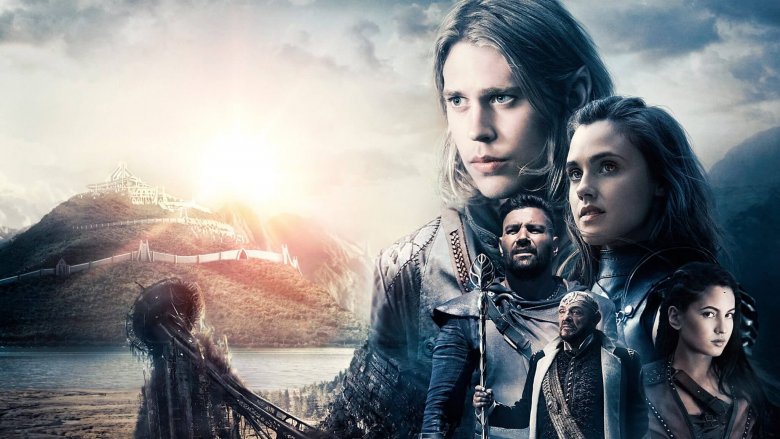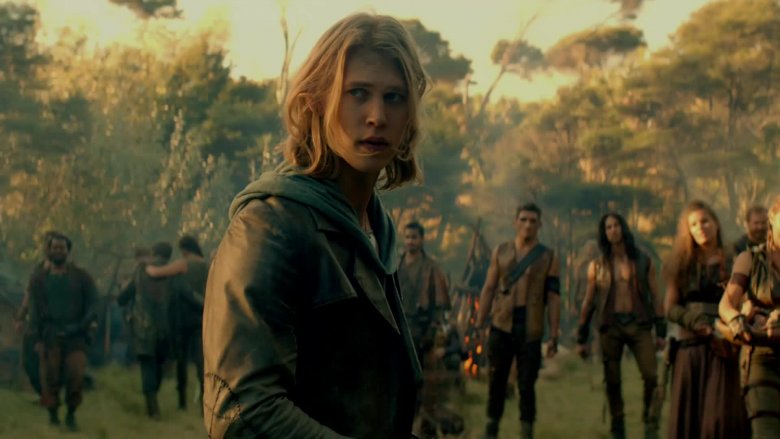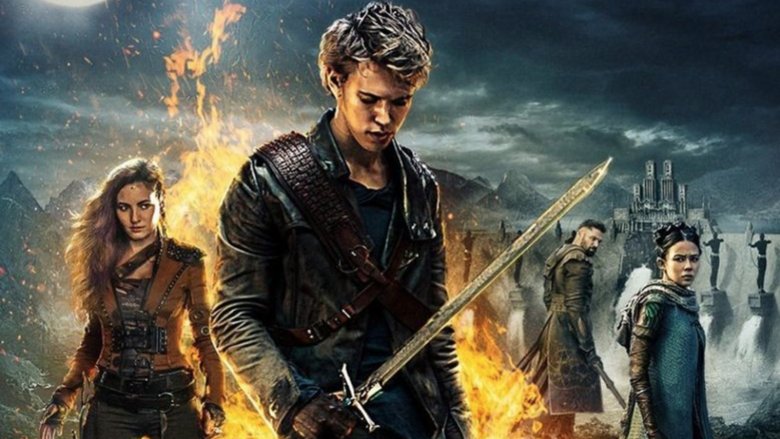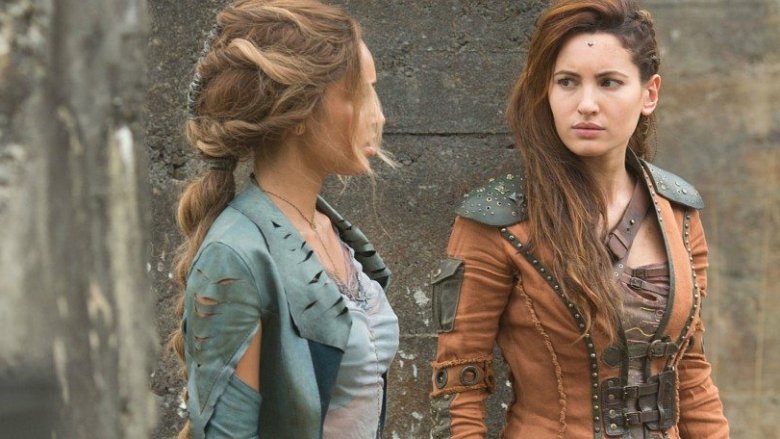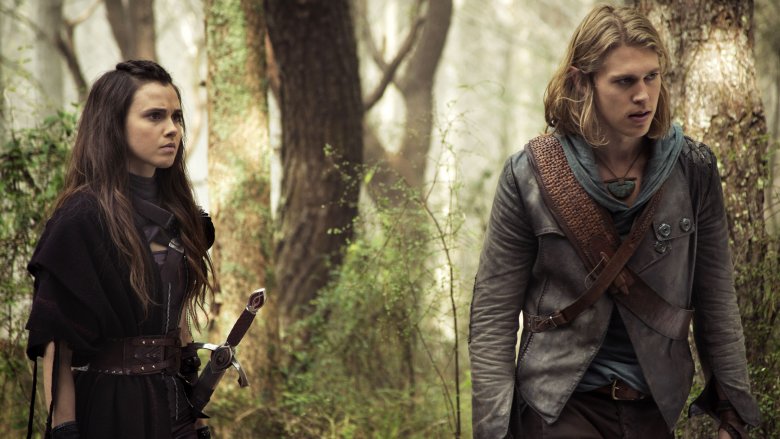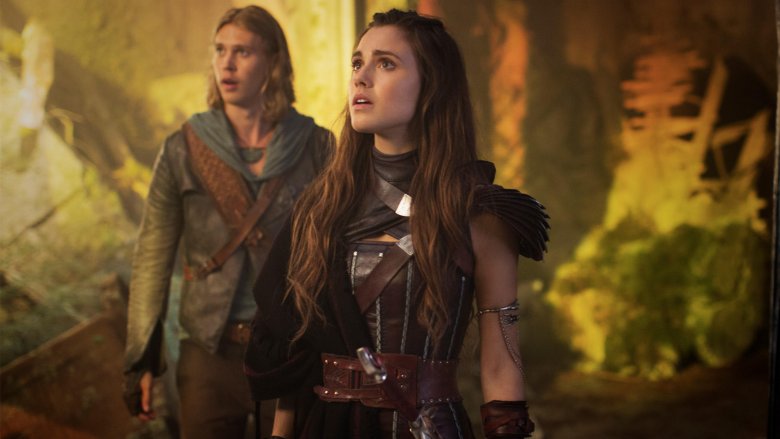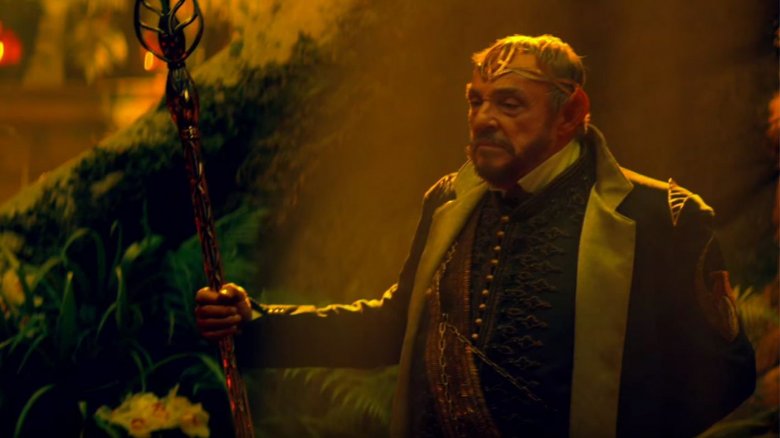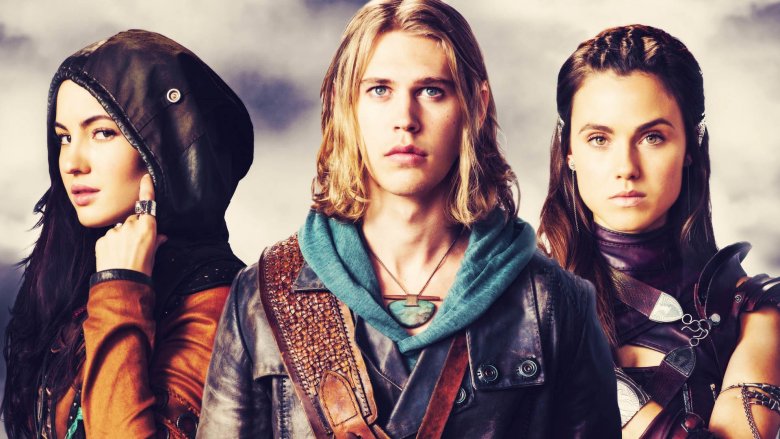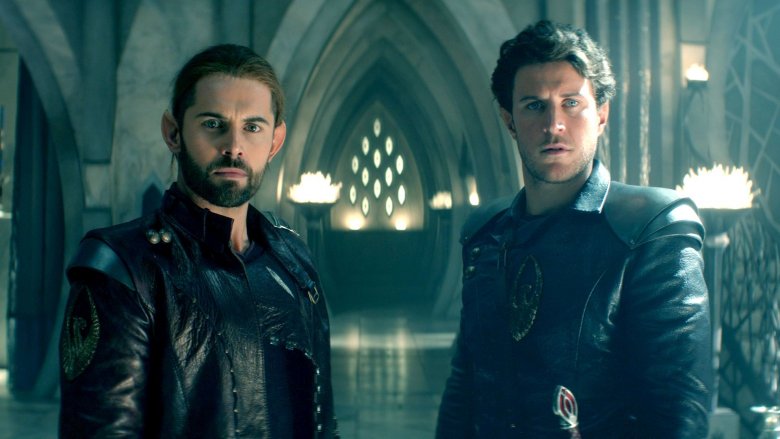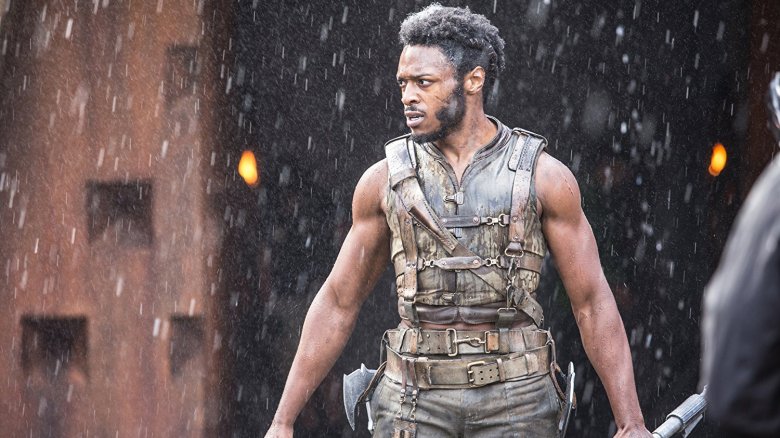The Real Reasons The Shannara Chronicles Was Canceled
When The Shannara Chronicles premiered on MTV in 2016, the fantasy series took audiences by storm. Dragons and zombies ruled the small screen, and with this adaptation of Terry Brooks' beloved Shannara book series, it looked as if the network had struck gold. MTV had found its own Game of Thrones — unfortunately, it only lasted for a short period of time.
After a promising premiere, the series hit one roadblock after another. And after confronting one too many challenges, The Shannara Chronicles was canceled after just two seasons. The writing was on the wall: season 2 premiered in October of 2017, only to come to its conclusion a little over a month later. In January of 2018, Viacom officially axed the hard fantasy series, leaving co-creators Alfred Gough and Miles Millar (Into the Badlands) shopping the program to other networks. What exactly happened? Here's a closer look at all the reasons why The Shannara Chronicles was canceled.
A promising start
When The Shannara Chronicles arrived on MTV, the show left quite an impact. Not only was this the first fantasy series of its kind for the network — offering competition to CW's The 100 and aiming for some Game of Thrones-style glory, it was MTV's most watched scripted series premiere. According to Futon Critic, the show pulled in an impressive 7.5 million viewers.
Nowadays it seems every network is looking for the next Game of Thrones. HBO is aiming to keep the Westeros action going even after the final season airs, with multiple spinoffs in development. Let's not forget Amazon's epic new Lord of the Rings series, which, according to The Hollywood Reporter, will cost an estimated $1 billion to make. The fantasy genre and young adult demographic go together like chocolate and peanut butter. In short, MTV had a surefire hit on its hands with The Shannara Chronicles.
Unfortunately, the show premiered during a time of transition. After MTV had produced a stretch of successful scripted shows — Teen Wolf, Awkward and Scream come to mind — they started shifting their lineup back to the inexpensive and wildly popular reality show format. And after a successful first season, the future of The Shannara Chronicles was suddenly in question.
Finding a new home at Spike TV
After ending its first season, it took over a year for the series return with new episodes. In that time, it became apparent that The Shannara Chronicles no longer fit MTV's brand. With Teen Wolf entering its final season, and the network pivoting away from the original scripted series format — instead, according to Deadline, MTV is expanding its TRL franchise — Viacom decided to move the fantasy program to sister station Spike for season 2.
Keeping the program in the Viacom family, the move to Spike gave the show the opportunity to up the ante on its edgy tone and action sequences. This pivot offered two problems, though. As TVTattle pointed out, when Spike TV launched in 2003, it was labeled "The First Network for Men." Over a decade later, that reputation proved hard to shake.
Not only was The Shannara Chronicles out of place in the network's bro-centric lineup, Spike didn't substantially advertise that it was the show's new home. Once season 2 premiered, viewership plummeted. As CinemaBlend reports, "At no point during its season 2 run did the live audience grow bigger than 310,000 people." That's a huge nosedive from the 7.5 million the show attracted in its series premiere. Basically, it wasn't a question of if the show would be canceled, but when.
Goodbye Spike, Hello Paramount Network
In February of 2017, TV Guide reported on Viacom's plans to rebrand Spike as the Paramount Network. Just two years after the network dropped the "TV" from its name, it seemed like Viacom was restructuring once again — with the aim of taking on more prestige programming to draw in viewers. With Spike's expiration date set for January 18, 2018, it felt as if this change of the guard would leave some shows in the dust. And just half a year after the rebrand was announced, season 2 of The Shannara Chronicles premiered.
"The Shannara Chronicles was one of two scripted series to make their Spike debut ahead of the network's pending transformation into the general entertainment Paramount Network, designed to be Viacom's leading scripted brand," noted Deadline. The other show to make the jump was a new adaptation of Stephen King's The Mist — which was canceled after one season.
While Spike hits like Bar Rescue and Lip Sync Battle survived the transition, The Shannara Chronicles joined a number of programs kicked to the curb by the network. In an era when content from heavy hitters like FX, AMC, Netflix, Hulu, and HBO reign supreme, Viacom was looking to their new Paramount Network as a beacon of hope. Water-cooler talks and Emmy consideration aside, the rebrand shifted focus to higher-end adult-focused content, leaving The Shannara Chronicles — and its young adult demographic — in the proverbial dust.
Too many liberties taken
George R.R. Martin's celebrated Game of Thrones novels provided huge inspiration for HBO's flagship series similar to the way in which Terry Brooks' books formed the basis for The Shannara Chronicles. And much like HBO's eventual move to depart from Martin's original subject matter, which was simply due to the author's inability to write the newest book quickly enough, season 2 of The Shannara Chronicles moved away from many of the plot points found in Brooks' tale. Forbes called the Game of Thrones pivot a good thing. After all, straying from material put the entire fandom on even ground. The small-screen story became even more impactful as no one knew what would come next.
Unfortunately, the same can't be said for the direction The Shannara Chronicles took in its final episodes. Taking creative liberties in adaptations such as these is tough ground to walk. Many creative choices on The Walking Dead have since come back to bite the show in the butt. MTV strayed so far from the original books that this Shannara Chronicles, according to Collider, became known as the "alt history version" of Terry Brooks' story.
Hard fantasy was a rough bet
When it comes to fantasy on TV, Game of Thrones easily changed the game for how the genre can be explored. As magical as things got in Westeros, audiences remained connected with the characters. Without that human element, and the intense drama that came with it, it's possible HBO's hit would've crashed and burned. The Shannara Chronicles was an outlier from the start. Tor called Brooks' books "Tolkien lite," and for good reason: this show was hard fantasy ... emphasis on hard. Picture a Dungeons & Dragons game come to life — elfs, mages, and warlocks, oh my!
This isn't a knock against the genre at all. But there's a specificity to the aesthetic the show had. Movies like The NeverEnding Story, Legend, and even The Princess Bride came to mind on multiple viewings of the series. As successful as those movies were, it proved to be quite a challenge in bringing a fantasy tale like this to the small screen. There was a clear lack of balance between the human element and outlandish fantasy unfolding onscreen.
"It's all pretty cheesy," said Forbes in their review of Season 1, "and made more so by just how sincere everyone comes across as. There's very little humor in the Shannara Chronicles, and far too much earnestness." Sure, The Shannara Chronicles was pretty to look at. But pretty ain't permanent.
A dated aesthetic
Terry Brooks' epic novels began in the late '70s and it's clear that The Shannara Chronicles production team were aiming to bring that lavish look to this TV adaptation. That's all well and good. But when it comes to adaptations such as this, it's been proven that a little modern day flair can go a long way. Margaret Atwood wrote The Handmaid's Tale in 1985, and Hulu has done a fabulous job of staying true to the tale while also updating its aesthetic for today's audiences.
"It's all very campy, almost generic fantasy," Forbes points out, "and has been long-ridiculed as such, even while the series has a pretty big fanbase." Season 1 of The Shannara Chronicles doubled down on the Lord of the Rings-style saccharin sweet tone that was all the rage in mid-'80s fantasy entertainment. For a show aimed at a younger demographic, the visuals and score ended up appealing to a nostalgic older crowd. In the end, the antiquated look and feel ultimately failed to connect with the millennial audience. Once season 2 premiered on Spike, it was obvious the end was nigh.
The cast was too pretty for its own good
The Shannara Chronicles told a dystopian story taking place thousands of years after a big war decimated humanity as we know it. This may be a small bone to pick, and it's a trope that pops up regularly throughout this type of primetime entertainment, but the main characters were just too pretty to look at. As io9 noted, "we're treated to a bunch of flat characters, many of which feel like they were on their way to a casting call for a show set in a high school."
If the world had been decimated, and human comforts we take for granted are no longer available, it's pretty understandable to expect our heroes to be battle worn. "Just because something is 'Young Adult' doesn't mean all the actors need to be perfect looking 20-year-olds without personalities who are immune to dust and grime," argued Forbes. Without a spec of dirt or imperfection anywhere on the cast's faces, this literally betrayed the overall ruined world the show was attempting to build.
It walked the walk, but didn't talk the talk
2,000 years in the future, after a giant war left civilization in ruins, heroes rise up ... and do so with a familiar-feeling modern day vernacular. This was one of The Shannara Chronicles' most distracting style choices. With genre shows such as this, audiences want authenticity. Sure, we got a fair share of British accents. But they all spoke like college students hanging out at the local Starbucks.
Tyrion Lannister never talks like this. There's a heaviness to his character that is expanded upon in the way he walks and talks. Unfortunately, The Shannara Chronicles got stuck trying too hard to relate to their millennial demographic. The A.V. Club called it "a fantasy show secretly designed to be drinking game," where each trope requires the viewer to take a shot.
That sounds fun and all, but it wasn't MTV's goal. "The dialogue is often painful, and painfully modern," pointed out Forbes. "It's not that I want a bunch of thee's and thou's mucking up the conversations, but I do want something resembling what people might sound like in this setting. Anyone over 22 basically achieves that. The younger cast? Not so much."
It was too late in addressing its diversity problem
The story of The Shannara Chronicles takes place roughly 2,000 years in the future. Much like Into the Badlands — the other fantasy series from co-showrunners Alfred Gough and Miles Millar — the program involved some detailed world-building. Yet unlike that AMC series, Shannara had a bit of a diversity problem. Macleans said the program "depicts a dystopian fantasy version of Seattle in which people of color are barely present." While there was a collection of strong females to reckon with here, season 1 of the series, aside from the occasional Asian face, was all white.
It seemed the production team got the memo once the show moved to Spike. The addition of actors like Riverdale's Vanessa Morgan (as Lyria) and UnREAL's Gentry White (who played Garet Jax) gave the show the edgy, relatable human element it had been lacking elsewhere. While the casting choices were spot on for the series, the MTV crowd didn't follow the series once it relocated. In the end, these character additions didn't do much to help the show's ratings. Too little, too late.
